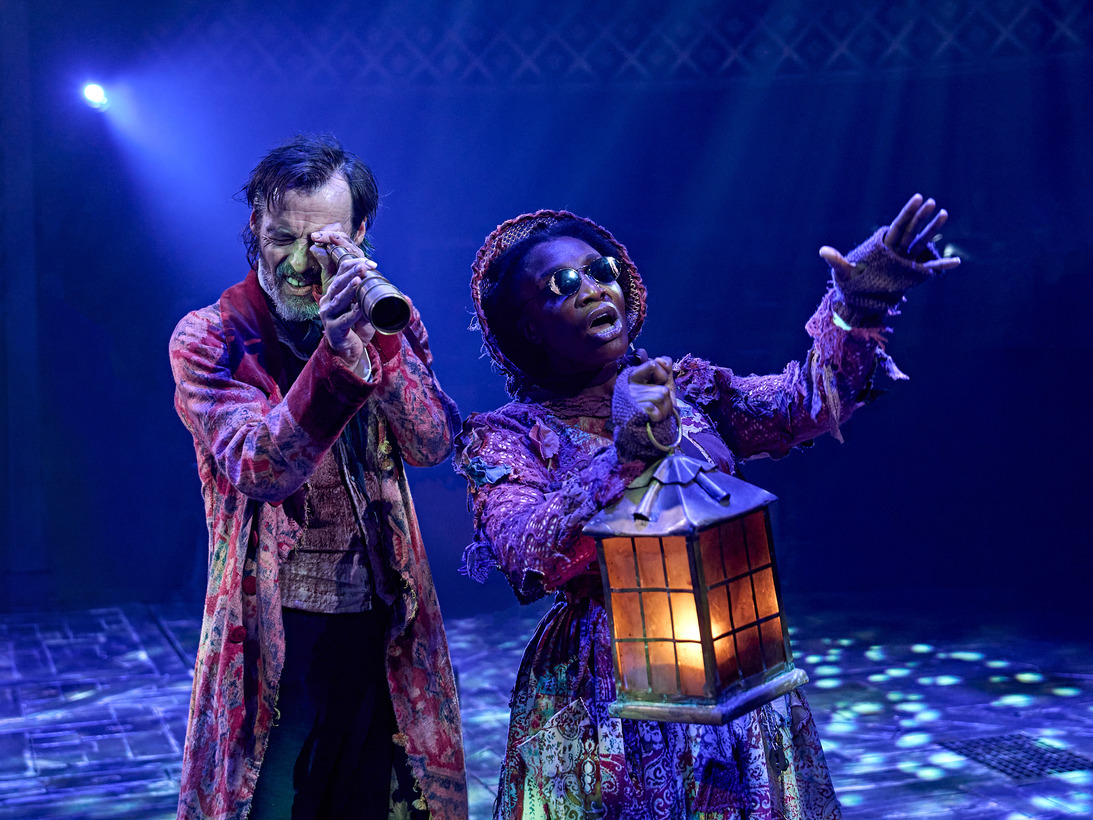Review: A CHRISTMAS CAROL at the Old Vic
It’s hard to go wrong with A Christmas Carol—it’s a classic and a favourite for a reason. Jack Thorne’s adaptation, directed by Matthew Warchus and returning to the Old Vic for its ninth year, doesn’t disappoint, offering a charming and heartwarming retelling of a familiar story. If it feels slightly predictable and a bit cloying in its themes, it’s easily forgiven by audiences delighted by the Christmas carol-centric score and the sense of nostalgic, child-like wonder evoked by its staging.
 Paul Hilton and Kibong Tanji in A CHRISTMAS CAROL at the Old Vic. Photo by Manuel Harlan.
Paul Hilton and Kibong Tanji in A CHRISTMAS CAROL at the Old Vic. Photo by Manuel Harlan.
Charles Dickens’ ghostly Christmas tale is the story of miserly money-lender Ebenezer Scrooge, who spurns the affection of his well-meaning nephew Fred and loyal employee Bob Cratchit in favour of a commitment to his work and a love for money. But on Christmas Eve, he’s visited by the spirit of his dead partner Jacob Marley and taken on a journey through time by the Ghosts of Christmas Past, Present, and Future, hoping to teach him the error of his ways before it’s too late.
Paul Hilton is superb as Scrooge, balancing a crotchety, sharp-tongued exterior with a hidden vulnerability and insecurity born of a childhood filled with poverty and abuse. Thorne’s exploration of Scrooge’s relationship with his abusive, debt-ridden father and sickly but optimistic sister bring a layer of depth to the character that makes him come across as softer and more sympathetic than he does in the text. Hilton also brings impeccable comedic timing to the part, with incredulous expressions and eye-rolls as he’s first confronted with the supernatural: “This is all a bit dramatic,” he quips at the sight of his first ghost, with just the right amount of wryness not to take away from the magnitude of the scene.
The ensemble cast, dressed in black Victorian tailcoats and hats that are reminiscent of undertakers, act as a Greek chorus, narrating passages from the book, including the famous opening, “Marley was dead, to begin with”, as well as providing musical accompaniment. This becomes slightly grating at times, especially when they pipe up, speaking in unison, during dramatic moments in the story, interrupting the production’s sense of immersion. As a way to work Dickens’ prose into the storytelling of a stage adaptation, it’s not quite effective.
Composer Christopher Nightingale’s music, however, is what saves the play from being as predictable as the many iterations that have come before it. From a haunting rendition of ‘Silent Night’ played on the handbells to a triumphant ‘Joy to the World’ sung during the climax as snow falls over the audience, Nightingale incorporates Christmas carols into the score in a way that feels powerful and enchanting rather than trite and hackneyed. The music is woven seamlessly into the storytelling, almost becoming a character in its own right.
Hugh Vanstone’s lighting design comes a close second in terms of creativity, animating Rob Howell’s minimalist set with a sense of enchanting whimsy. Dozens of lanterns overhead convert the stage in the round into a ghostly, atmospheric setting, immersing the audience into Victorian London. The lanterns flicker to signal the arrival of supernatural entities, drop from the ceiling during dramatic moments, and become props in the hands of the characters. Each Ghost carries a lantern of varying sizes, and Scrooge often snatches them away in an attempt to seize back control of the narrative he has been dropped into.
Tonally, the production feels a bit all over the place. There are deeply poignant moments, such as when Scrooge witnesses his father hit his younger self and falls over as if he can still feel the blow years later, or when he embraces his younger self in a powerful moment of self-love and self-acceptance. In other places the themes of love and charity feel a bit heavy-handed in their delivery, bordering on the saccharine. The ending tilts slightly towards the farcical, with food raining down from above as the characters, with the audience’s aid, scramble to put together a Christmas feast for the Cratchits. But this fits in with the interactive elements of the production, which opens with musicians moving through the audience pre-show, handing out mince pies and tangerines.
One can forgive the slight cheesiness, especially when the show ends on a joyful, hopeful note, with a jubilant jig and a request to donate to Feeding Britain as a tribute to Dickens’ exploration of poverty and charity. The production appeals to our inherent feeling of nostalgia towards a familiar, beloved story and the comfort evoked by the idea of Christmas and all it represents. Without those things, it might have felt a bit trite and wobbly, but as it stands, it sets out what it achieves to do.
Latest News

 Review: A CHRISTMAS CAROL at the Old Vic
26 November 2025 at 18:28
Review: A CHRISTMAS CAROL at the Old Vic
26 November 2025 at 18:28

 Cast announced for SWEETMEATS World Premiere at Bush Theatre
26 November 2025 at 16:19
Cast announced for SWEETMEATS World Premiere at Bush Theatre
26 November 2025 at 16:19

 Cast announced for UK premiere of HERE THERE ARE BLUEBERRIES
26 November 2025 at 14:34
Cast announced for UK premiere of HERE THERE ARE BLUEBERRIES
26 November 2025 at 14:34

 Review: BALLET SHOES at National Theatre (Olivier)
26 November 2025 at 14:11
Review: BALLET SHOES at National Theatre (Olivier)
26 November 2025 at 14:11